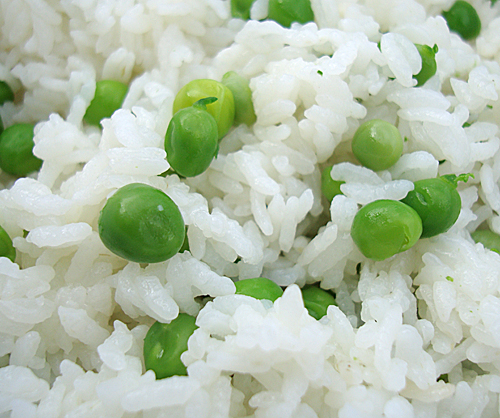Spring maze gohan: Green pea rice, Asparagus rice

It's finally spring, which means some of my favorite vegetables are showing up at the markets. One way I like to enjoy them is to make maze gohan (混ぜご飯), which just means 'mixed rice', featuring the ingredient in question. Maze gohan (pronouned mazeh-go-han) differs from takikomi gohan (炊き込みご飯), such as this mushroom rice, where the ingredients are cooked with the rice. Maze gohan is more suited for delicate ingredients. It's also a frugal way of stretching the use of some rather more expensive vegetables, such as really fresh peas. Because the rice is subtly flavored, you don't need a lot of other things in your bento box.
Here are two very simple recipes for spring maze gohan.
Green pea rice
Makes about 5-6 cups of cooked rice
- 2 cups (about 500ml) shelled raw green peas
- 2 rice cooker cups of uncooked rice, or 1 1/2 US cups (about 360ml)
- 1 Tbs. sake
- 1 tsp. salt
- Pinch of dashi granules (optional)
- The appropriate amount of water for cooking the rice
- Water and salt for cooking the peas
Wash the rice as you normally would (see how to wash and cook rice). Add the sake, salt and pinch of dashi granules to the water, and cook the rice as you normally would.
When the rice is done, boil the green peas until just tender in salted water. Drain, and mix in to the rice gently so that you don't crush the peas.
This is good warm or cooled, so it is of course great for bentos.
Variations
You can use the same method for fava beans or broad beans. Cook them in salted water until tender, then take the skins off. This is a very traditional maze gohan called soramame gohan (Incidentally, soramame (空豆), the word for fava beans/broad beans, means 'sky beans').
Out of season, you can use frozen peas, though the fragrance won't be quite the same.
You can also use edamame instead, fresh or frozen.
Asparagus rice

Asparagus is not a traditionally known vegetable in Japan, though in recent decades it's become very popular. I use the stalk parts of the asparagus stalks after using the tips in something else, so it ends up being quite economical.
Makes about 5-6 cups of cooked rice
- 2 cups (about 500ml) cut up asparagus stalks
- 2 rice cooker cups of uncooked rice, or 1 1/2 US cups (about 360ml)
- 1 Tbs. mirin
- 1 tsp. salt
- Pinch of dashi granules (optional)
- Pinch of sugar (optional, but it does enhance the flavor of the asparagus)
- The appropriate amount of water for cooking the rice
- Water and salt for cooking the asparagus
The method is the same as for the green pea rice.
Wash the rice as you normally would (see how to wash and cook rice). Add the sake, salt and pinch of dashi granules to the water, and cook the rice as you normally would.
When the rice is done, boil the cut up asparagus stalks until just tender in salted water. Drain, and mix in to the rice gently.
This is good warm or cooled, so it is of course great for bentos. This one is especially good with a bit of toasted sesame seed sprinkled on top.
Extra: Here's some pea porn!
Whenever I'm shelling peas or fava beans, I always wonder if's worth all the trouble. All those pods going to the compost, vs. the tiny mound of peas or beans. And the frozen kind are so handy! Of course, once I taste those fresh peas, it all makes sense.
If you enjoyed this article, please consider supporting this site by becoming my patron via Patreon.

